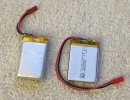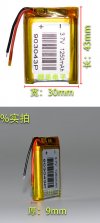Pouch Cell
In 1995, the pouch cell surprised the battery world with a radical new design. Rather than using a metallic cylinder and glass-to-metal electrical feed-through, conductive foil-tabs were welded to the electrodes and brought to the outside in a fully sealed way. Figure 6 illustrates a pouch cell.

Figure 6: The pouch cell.
The pouch cell offers a simple, flexible and lightweight solution to battery design. Some stack pressure is recommended but allowance for swelling must be made. The pouch cells can deliver high load currents but it performs best under light loading conditions and with moderate charging.
Source: A123
The pouch cell makes most efficient use of space and achieves 90–95 percent packaging efficiency, the highest among battery packs. Eliminating the metal enclosure reduces weight, but the cell needs support and allowance to expand in the battery compartment. The pouch packs are used in consumer, military and automotive applications. No standardized pouch cells exist; each manufacturer designs its own.
Pouch packs are commonly Li-polymer. Small cells are popular for portable applications requiring high load currents, such as drones and hobby gadgets. The larger cells in the 40Ah range serve in energy storage systems (ESS) because fewer cells simplify the battery design.
Although easily stackable, provision must be made for swelling. While smaller pouch packs can grow 8–10 percent over 500 cycles, large cells may expand to that size in 5,000 cycles. It is best not to stack pouch cells on top of each other but to lay them flat, side by side or allow extra space in between them. Avoid sharp edges that can stress the pouch cells as they expand.
Extreme swelling is a concern. Users of pouch packs have reported up to 3 percent swelling incidents on a poor batch run. The pressure created can crack the battery cover, and in some cases, break the display and electronic circuit boards. Discontinue using an inflated battery and do not puncture the bloating cell in close proximity to heat or fire. The escaping gases can ignite.







